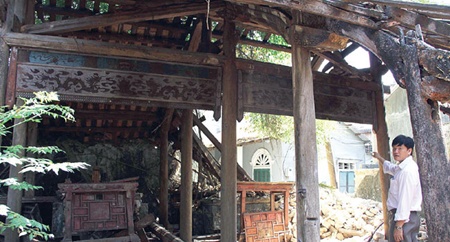The 200-year-old Duong Pham communal house in Hue is in ruins despite its historical and architectural values.
 |
| Under threat: Ho Dung, chairman of the Phu Nhuan Ward, talks about the dilemma of protecting the Duong Pham communal house. |
All the wooden structures of the house, which was designed based on the style of nha ruong (wooden house with many beams and pillars), have collapsed. Altars that were once set for gods and the founders of the village lie exposed to both sun and rain.
Meanwhile, the house's surrounding land is illegally occupied by six households. Local people living near the house, which is located in the former royal capital, Hue City's Phu Nhuan Ward, continue to take bricks from its broken fencing walls.
According to researcher Ho Tan Phan, Duong Pham Village is one of the earliest villages with land that later formed the urban Hue City.
"The development of Hue originated from the communities that were formed in the ancient villages, which include Duong Pham. Thus, we need to respect the structure to preserve part of Hue's history," he noted.
Phan suggested that due to urbanisation, local authorities could take part of the house's land for constructing community institutions, but the iconic building should be preserved as a heritage site for Hue.
Researchers at the Vietnam Institute for Culture and Art Study in Hue have carried out several studies on ancient communal houses in the city, and they have highlighted the architectural values of the house as well as the unique carving patterns on its beams, panels and altars.
The experts believe that the present carving masters cannot create such artistic wooden carvings.
Authorities of the city have ordered Phu Nhuan Ward, where the house is located, to dismantle the house completely, and use the land for a public building.
"We are in a dilemma as we do not dare to ruin the house because this is the property of our ancestors. Dismantling it completely is something we should reconsider culturally and spiritually," said Ho Dung, chairman of the ward.
Dung pointed out that the ward has asked city authorities to construct a concrete building that makes use of the wooden structures of the house on a total area of 500 square metres of the old building. The remaining land area can be used for community activities.
"But they have not approved or even abandoned our proposal for years. We cannot move the illegal occupying households and provide proper protection to the house without a clear decision from the city authorities," he added.
Dedicated researchers in Hue wanted the city to preserve the house. "The house should be conserved as it is based on a road with many royal monuments that is suitable for historical tourism or cultural activities," said researcher Phan.
Near the house are the An Dinh Palace, constructed in the French style; the memorial house to the latest queen of the Nguyen dynasty (1802–1945); and many other private residences of former royal family members.
Hue natives and researchers believe that the restoration of the house will enhance the beautiful view of the road running along the famous An Cuu Canal in Hue.
No comments:
Post a Comment